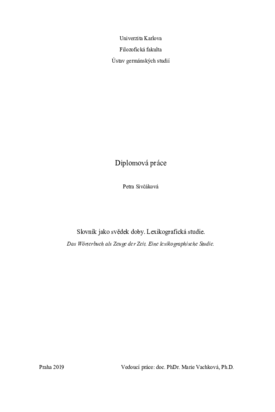Wörterbuch als Zeuge der Zeit
The Dictionary as Time Witness
Slovník jako svědek doby
diploma thesis (DEFENDED)

View/
Permanent link
http://hdl.handle.net/20.500.11956/110942Identifiers
Study Information System: 192297
Collections
- Kvalifikační práce [24986]
Author
Advisor
Referee
Šemelík, Martin
Faculty / Institute
Faculty of Arts
Discipline
German Language and Literature - Translation Studies: Czech - German
Department
Institute of Germanic Studies
Date of defense
2. 9. 2019
Publisher
Univerzita Karlova, Filozofická fakultaLanguage
German
Grade
Very good
Keywords (Czech)
kontrastivní lexikografie|překladový slovník|německo-český|slovní zásoba|Československo 1918-1938Keywords (English)
contrastive lexicography|bilingual dictionary|german-czech|vocabulary|Czechoslovakia 1918-1938Předložená lexikografická studie si klade za úkol porovnat zpracování módní terminologie s důrazem na 20. léta 20. století ve dvou překladových německo-českých slovnících z první pol. 20. stol.: Encyklopedický německo-český J.V. Sterzingera (1916-1935) a Příruční německo-český J. Janka/H. Siebenscheina (1936-1944). Záměrem je vysledovat rozdíly ve výstavbě lexikografického hesla, popř. vystopovat důvody jeho (ne)přítomnosti ve slovníku. Pro výzkum byly stanoveny dvě hypotézy: 1. Nová módní terminologie vzniklá za určitých kulturně-historických podmínek je zastoupena pouze v mladším z obou slovníků, 2. Frekvence módní terminologie je v encyklopedickém slovníku vyšší než v příručním. Na vzorku 370 módních termínů byla provedena kvantitativní analýza, při které byla vyvrácena teze č. 2. Bylo zjištěno, že zastoupení módní terminologie dané zkoumaným vzorkem je v obou slovnících rovnoměrné. Kvantitativně-kvalitativní analýza výstavby lexikografického hesla jednotlivých módních termínu potvrdila hypotézu č. 1. Na základě užití slovníkových značek pro jazyk bylo zjištěno, že módní terminologie typická pro 20. léta 20. století je v mladším ze slovníků četnější.
The aim of this lexicographical study is to compare the fashion terminology with an emphasis on the 1920s in two German-Czech dictionaries from the first half of the 20th century: Encyclopaedic German-Czech Dictionary by J. V. Sterzinger (1916-1935) and German-Czech Concise Dictionary by J. Janko/H. Siebenschein (1936-1944). The intention is to trace differences in the structure of a lemma and to trace the reasons for its presence (or absence) in the dictionary. Two hypotheses were established for the research. No. 1: New fashion terminology created under certain cultural-historical conditions is represented only in the younger of the two dictionaries; No. 2: The frequency of fashion terminology is higher in the encyclopaedic dictionary than in the concise dictionary. A quantitative analysis was performed on a sample of 370 fashion terms, refuting hypothesis No. 2. It was found that the representation of fashion terminology is similar in both dictionaries. The quantitative- qualitative analysis of the lemma microstructure of the individual fashion terms confirmed hypothesis No. 1. The analysis revealed that the english fashion terminology typical of the 1920s is more frequent in the younger of the two dictionaries.
